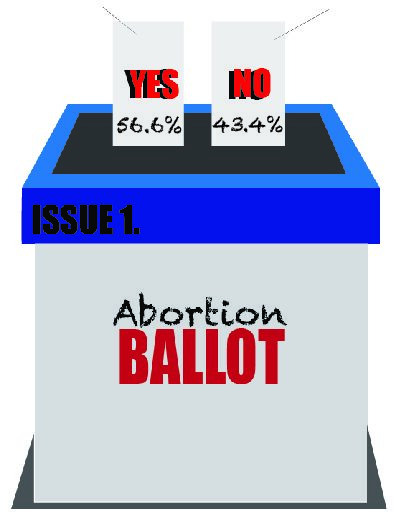
photo credit: Zion Clifton
Ohio just experienced another election, and it was anything but a sleepy, boring midterm election. Among other things on the ballot, issue one, on women’s reproductive rights, and issue two, the legalization of recreational marijuana, caused an abnormally high voter turnout for this election year.
This year was an off year election, meaning there were no major federal elections being held.
“Voter turnout in an off-year election is normally very low. There are no federal offices up for elections, no house representatives, senators, presidents and typically Ohioans don’t show up to vote just how,” AP Government teacher John Carmichael said.
However, this year, that was not the case.
According to the Ohio Secretary of State Office and Spectrum News, more than 3.9 million Ohioans voted in this November’s election, about 800,000 more than what was seen back in August.
The main contributor to the mass increase in voter turnout has to do with the controversy surrounding issue one on women’s reproductive rights.
“While it’s debatable, certainly abortion as a subject by itself is one of the most controversial debatable issues we have period. Perhaps guns would be the other one but it’s hard to think of something more controversial,” Carmichael said.
When a subject is as controversial, the topic in politics is known as a wedge issue.
“Wedge issues are things that divide people and abortion is one of them. It’s one of the most divisive wedge issues we have ever seen,” Carmichael said
Women’s reproductive rights are important to a lot of people, no matter what viewpoint someone may have.
“Making a choice for my body and the empowerment of having control over my body is extremely important to me. Since this issue could change that control, I care about it deeply,” senior Kyleigh Jochum said.
In the end, Ohioans overwhelmingly passed Issue one, a constitutional amendment, with 56 percent of the vote in favor, according to Bricker and Eckler, a law firm located in Central Ohio.
For Ohioans, this means women will have the freedom to decide whether they would like to get an abortion within certain constraints stated in the issue.
Those constraints allow the state to prohibit abortion after fetal viability, which is generally between 22 and 24 weeks into the pregnancy, except when necessary to protect the life or health of the mother, according to the Hill.
However, even though the issue is passed, that doesn’t mean that everything goes into effect immediately.
The issue will not take effect until this December, but it will not be implemented until courts apply the new constitutional standard to related lawsuits, most notably the ones that are challenging the current ban, according to the Hill.
With the controversy surrounding the topic, push-back was inevitable.
Some Ohio Republican lawmakers are proposing to take away the court’s authority to review cases related to implementing the passage of Issue one. In a statement, 4 Republican lawmakers claimed without evidence that there was a foreign election interference in the vote to pass issue one. Additionally, they threatened to block the ability of courts to interpret the new constitutional amendment, according to the Hill.
As this continues to unfold, there is another major issue that was voted on and passed this November. Issue two was an initiative position, meaning it was initiated by citizens, to legalize the use of recreational marijuana.
“Initiative positions allow average citizens to bring up an issue that they are interested in. This was not driven by a political party; this was driven at the grass roots by citizens who felt a need and want to be able to smoke marijuana recreationally without it going on their criminal record,” Carmichael said.
There is another reason behind why the legalization of marijuana has become more popular throughout many states including Ohio.
“Issue 2 is going to bring in so much tax revenue to the state and some states are finding hundreds of millions of dollars that they didn’t have before,” Carmichael said.
For example, California now regularly gains more than $1 billion per year in tax revenue from marijuana. In addition, in 2022, states reported a combined total of $15.16 billion in tax revenue from recreational cannabis sales, according to the Motley Fool, a private financial and investing advice company.
Many other states have legalized marijuana for this reason. The passage of issue two will more than likely bring in a lot of money into Ohio as well.
It is predicted by The Ohio State University Drug Enforcement and Policy Center that Ohio will receive an additional $276 million to $404 million annual tax revenues from legal marijuana in the 5th
year after legalization, according to Harm Reduction Ohio.
“I would just say that from the tax base alone that the revenue from the marijuana is going to end up in the legislature and they are going to be able to allocate more money for schools because they will have more interest,” Carmichael said.
Despite all of this, some people do have doubts about the passage of this issue.
Protect Ohio Workers and Families, along with several other organizations, is the group that is leading the campaign against issue two. Additionally, Mike DeWine has expressed his opposition to the initiative as well, one of his concerns being that legalizing the drug would send the wrong message to children and pose danger to them, according to Idea Stream Public Media.
Overall, the passage of both issues is major. One thing is for sure, as there is pushback and both issues are implemented into law, these issues will continue to be major topics in the news and of debate.


